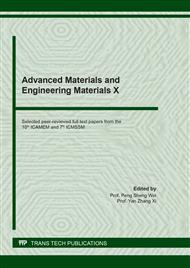[1]
W.J. Zhang, X.Y. Song, S.X. Hui, W.J. Ye, Y.L. Wang, W.Q. Wang, Tensile behavior at 700 ℃ in Ti- Al-Sn-Zr-Mo-Nb-W-Si alloy with a bi-modal microstructure. Mater. Sci. Eng. A 595 (2014) 159-164.
DOI: 10.1016/j.msea.2013.11.096
Google Scholar
[2]
W.J. Zhang, X.Y. Song, S.X. Hui, W.J. Ye, Y.L. Wang, W.Q. Wang, Effect of single annealing on microstructure and mechanical properties of BTi-6431S titanium alloy. Chin J Nonferrous Met. 6 (2013) 1530–1536. (in Chinese).
Google Scholar
[3]
W.J. Zhang, X.Y. Song, S.X. Hui, W.J. Ye, The effects of Mo content on microstructure and high 316 temperature tensile behavior of Ti-6.5Al-2Sn-4Zr-xMo-2Nb-1W-0.2Si titanium alloys. Mater. High, Temp. 34 (2017) 179-185.
DOI: 10.1080/09603409.2016.1266763
Google Scholar
[4]
W.J. Zhang, X.Y. Song, S.X. Hui, W.J. Ye, W.Q. Wang, Phase precipitation behavior and tensile 322 property of a Ti–Al–Sn–Zr–Mo–Nb–W–Si titanium alloy. Rare Metals. 37 (2018) 1064-1069.
DOI: 10.1007/s12598-015-0666-3
Google Scholar
[5]
W.J. Zhang, H.F. Xie, S.X. Hui, W.J. Ye, Y. Yu, X.Y. Song, L.J. Peng, G.J. Huang, Z. Yang, In-Situ SEM observation on fracture behavior of titanium alloys with different slow-diffusing β stabilizing elements, Materials. 13(8) 2020, 1848.
DOI: 10.3390/ma13081848
Google Scholar
[6]
S.Q. Wang, W.Y. Li, Y. Zhou, X. Li, D.L Chen, Tensile and fatigue behavior of electron beam welded 308 dissimilar joints of Ti–6Al–4V and IMI834 titanium alloys, Mater. Sci. Eng. A 649 (2016) 146-152.
DOI: 10.1016/j.msea.2015.09.107
Google Scholar
[7]
V.K. Chandravanshi, A. Bhattacharjee, S.V. Kamat, T.K. Nandy, Influence of thermomechanical 305 processing and heat treatment on microstructure, tensile properties and fracture toughness of Ti-1100-0.1B 306 alloy, J. Alloy. Compd. 589 (2014) 336-345.
DOI: 10.1016/j.jallcom.2013.11.014
Google Scholar
[8]
W.J. Jia, W.D. Zeng, Y.G. Zhou, J.R. Liu, Q.J. Wang, High-temperature deformation behavior of Ti60 titanium alloy, Mater. Sci. Eng. A 528 (2011) 4068-4070.
DOI: 10.1016/j.msea.2011.01.113
Google Scholar
[9]
C. Ding, Q. Shi, X. Liu, L. Zheng, R.X. Li, Z.X. Huang, B.Y. Yu, W. Wei, Microstructure and mechanical properties of PM Ti600 alloy after hot extrusion and subsequent annealing treatment. Mater. Sci. Eng. A 748 (2019) 434-440.
DOI: 10.1016/j.msea.2019.01.099
Google Scholar
[10]
X.M. Yang, H.Z. Guo, Z.K. Yao, S.C. Yuan, Effect of isothermal forging strain rate on microstructures and mechanical properties of BT25y titanium alloy. Mater. Sci. Eng. A. 673 (2016) 355-361.
DOI: 10.1016/j.msea.2016.07.084
Google Scholar
[11]
S.Y. Wei, Q.J. Wang, Y. He, Z.Q. Chen, Y.Y. Liu, Review of BT25 and BT25y titanium alloys for aero-engine. Titan Ind Prog. 30 (2013) 9-14. (In Chinese).
Google Scholar
[12]
J.H. Qian, Application and Development of New Titanium Alloys for Aerospace. Rare Met. 2000; 24 (3): 218-223. (In Chinese).
Google Scholar
[13]
M.Y. Hao, J.M. Cai, J. Du, The effect of heat treatment on microstructure and properties of BT36 high temperature alloy. J Aeronaut Mate. 23 (2) 2003: 14-17. (In Chinese).
Google Scholar
[14]
J.M. Cai, M.Y. Hao, X.M. Li, J.M. Ma, C.X. Cao, Study on composition character and microstructure of BT36 high temperature Ti alloy. J. Mater Eng. 2 (2000) 10–12. (in Chinese).
Google Scholar
[15]
W.J. Zhang, X.Y. Song, S.X. Hui, W.J. Ye, In-situ SEM observations of fracture behavior of BT25y alloy during tensile process at different temperature. Mater. Des. 116 (2017) 638-643.
DOI: 10.1016/j.matdes.2016.12.050
Google Scholar
[16]
Y. Wang, B. Lu, J. Zhang, Effects of heat treatment on microstructure and mechanical properties of high Mo equal titanium alloy BT25y. Heat. Treat. Met. 4 (2009) 64-68. (In Chinese).
Google Scholar
[17]
A.K. Gogia, High-temperature titanium alloys. Defence. Sci. J. 55 (2005)149–173.
Google Scholar


